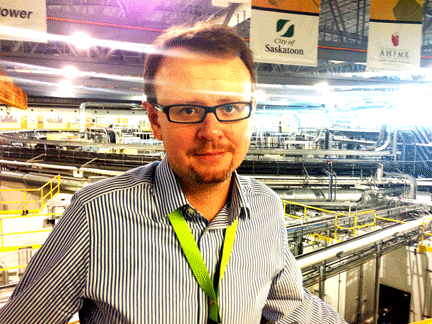CLS scientists support Middle East project
Scientists at the Canadian Light Source (CLS) synchrotron are supporting an ambitious science project in one of the world’s most volatile regions that could help bring diplomacy and even some peace to the Middle East.
By Colleen MacPherson SESAME, the Synchrotron-light for Experimental Science and Applications in the Middle East, is the largest science project in the region and one of the only collaborative projects involving several Arab nations, as well as Jordan, Turkey, Cyprus, Iran and Israel.
SESAME, the Synchrotron-light for Experimental Science and Applications in the Middle East, is the largest science project in the region and one of the only collaborative projects involving several Arab nations, as well as Jordan, Turkey, Cyprus, Iran and Israel.
CLS Industrial Staff Scientist Eli Stavitski recently returned from Amman, a city in the north of Jordan, where he met with scientists and stakeholders for the new SESAME facility to provide them with expertise on designing experiments. Stavitski presented a seminar on using synchrotron infrared light techniques to conduct world-class research. The CLS is one of the world's best facilities to study samples using a wide range of infrared research techniques and scientists were recruited to lend support in getting SESAME's infrared experiments off the ground.
"SESAME is creating a critical mass for scientists in the region, helping them work across borders," said Stavitski. "The level of collaboration day to day on this project is impressive."
Stavitski said this is especially true when you consider stakeholders from nations with tense relations like Israel and Iran putting differences aside to ensure the success of SESAME.
Synchrotrons work by accelerating particles, like electrons, in a tubular ring at nearly the speed of light. When the electrons are manipulated, scientists can use a spectrum of very bright light to conduct research on everything from nanotechnology, pharmaceuticals, to new medical imaging and radiation therapy techniques.
SESAME will join an elite family Âas there are only about 40 synchrotrons around the world. Some, like the CLS or the Diamond Light Source in the UK, are about the size of a football field. The world's largest particle accelerator, the Large Hadron Collider at the European Organization for Nuclear Research, or CERN, is 27 Km in circumference. The new synchrotron will be much smaller than CERN but hopes to achieve the same level of large-scale diplomacy. Just as CERN was set up following World War II to bring together scientists from adversarial nations, the first discussions for SESAME began in the 1990's following the Gulf War to bring together scientists from across the Middle East.
SESAME still faces obstacles though as the constant threat of political breakdown or conflict could force key countries to cancel funding or back out of the project all together. But even with the recent conflict involving Hamas in Gaza and Israel, Stavitski said there are no signs of any country backing out.
According to news reports from the BBC, some are calling the project a success already because it has brought together scientists and politicians from countries that would not normally meet. It has also given hope to scientists who would have left the region to conduct their experiments at synchrotrons in other countries.
CLS scientists will continue to lend support to the project through expertise and experience, said Stavitski.
Experiments at the SESAME synchrotron are expected to begin in 2015.

